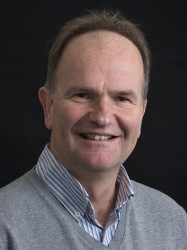Summary
Graham Williams became Professor of Endocrinology at Imperial College London in 2005. He obtained a BSc in Anatomy and MBBS from St. Thomas’s Hospital, University of London, a PhD from the University of Birmingham, and a DSc from Imperial College London. He trained as a Howard Hughes Medical Institute Fellow at Harvard Medical School, Boston, USA and as a Medical Research Council Training Fellow and Clinician Scientist Fellow at the University of Birmingham. He was appointed as Senior Lecturer at the Royal Postgraduate Medical School, London (1995) and received an MRC Career Establishment Award. He was promoted to Reader (2000) and subsequently Professor (2005).
Professor Williams is Head of the Molecular Endocrinology Laboratory in the Department of Metabolism, Digestion and Reproduction at Hammersmith Campus. His research focuses on the (i) genetic origins of bone and cartilage disease and (ii) molecular mechanisms of thyroid hormone action during skeletal development and in adult bone maintenance and tissue repair. This research is internationally recognised and the laboratory is generously funded by a Wellcome Trust Strategic Award, MRC Research Grant, European Commission Horizon 2020 Award and Wellcome Trust Investigator Award. Professor Williams receives regular invitations to speak at international scientific meetings all over the world and the laboratory collaborates widely throughout the UK, Europe, USA and Asia. Clinical Training Fellows, PhD students and post-doctoral scientists in the Molecular Endocrinology Group have received 59 prizes for research excellence.
Professor Williams was awarded the Society for Endocrinology Medal (2011), Bermuda Hospitals Board Edwin B. Astwood Memorial Lecture (2011), European Thyroid Association Merck Serono Prize (2012), Danish Thyroid Association Distinguished Annual Lectureship Award (2014), American Thyroid Association Sidney H. Ingbar Distinguished Lectureship Award (2014), British Thyroid Association Pitt-Rivers Medal (2016) and European Calcified Tissue Society Steven Boonen Clinical Research Award (2018). He received a Wellcome Trust Investigator Award (2016-2022).
Professor Williams served as President of the European Thyroid Association (2021-2023) and was previously a member of the ETA Executive Committee (2008-2011). He also served as President of the Society for Endocrinology (2016-2019) and was the Treasurer and a Member of Council (2010-2016). Furthermore, he was President of the British Thyroid Association (2011-2014) and twice a member of the BTA Executive (2003-2009 & 2011-2015).
Professor Williams has served on numerous Scientific Advisory Boards, Editorial Boards, Grant Review Panels and Scientific Programme Organising Committees over the years and was elected as a Fellow of the Academy of Medical Sciences (2019), a Fellow of the Association of Physicians of Great Britain & Ireland (2021) and Member of the Academia Europaea (2021). He was appointed OBE for services to Endocrinology in the King's Birthday Honours List (2023).
Selected Publications
Journal Articles
Youlten SE, Kemp JP, Logan JG, et al., 2021, Osteocyte transcriptome mapping identifies a molecular landscape controlling skeletal homeostasis and susceptibility to skeletal disease, Nature Communications, Vol:12, ISSN:2041-1723, Pages:1-21
McDonald MM, Khoo WH, Ng PY, et al., 2021, Osteoclasts recycle via osteomorphs during RANKL-stimulated bone resorption., Cell, Vol:184, Pages:1330-1347.e13
Steinberg J, Southam L, Roumeliotis TI, et al., 2021, A molecular quantitative trait locus map for osteoarthritis., Nat Commun, Vol:12
Butterfield NC, Curry KF, Steinberg J, et al., 2021, Accelerating functional gene discovery in osteoarthritis., Nat Commun, Vol:12
Morris JA, Kemp JP, Youlten SE, et al., 2019, An atlas of genetic influences on osteoporosis in humans and mice., Nat Genet, Vol:51, Pages:258-266
Jo S, Fonseca TL, Da Costa Bocco BM, et al., 2019, Type 2 deiodinase polymorphism causes ER stress and hypothyroidism in the brain, Journal of Clinical Investigation, Vol:129, ISSN:0021-9738, Pages:230-245
Rauner M, Baschant U, Roetto A, et al., 2019, Transferrin receptor 2 controls bone mass and pathological bone formation via BMP and Wnt signaling, Nature Metabolism, Vol:1, ISSN:2522-5812, Pages:111-124
Hönes GS, Rakov H, Logan J, et al., 2017, Noncanonical thyroid hormone signaling mediates cardiometabolic effects in vivo., Proc Natl Acad Sci U S A, Vol:114, Pages:E11323-E11332
Kemp JP, Morris JA, Medina-Gomez C, et al., 2017, Identification of 153 new loci associated with heel bone mineral density and functional involvement of GPC6 in osteoporosis., Nat Genet, Vol:49, Pages:1468-1475
Bassett JH, Williams GR, 2016, Role of thyroid hormones in skeletal development and bone maintenance., Endocrine Reviews, Vol:37, ISSN:1945-7189
Blum MR, Bauer DC, Collet T-H, et al., 2015, Subclinical thyroid dysfunction and fracture risk: A meta-analysis, Jama-journal of the American Medical Association, Vol:313, ISSN:1538-3598, Pages:2055-2065
Bassett JHD, Gogakos A, White JK, et al., 2012, Rapid-Throughput Skeletal Phenotyping of 100 Knockout Mice Identifies 9 New Genes That Determine Bone Strength, Plos Genetics, Vol:8, ISSN:1553-7404
Bassett JHD, Boyde A, Howell PGT, et al., 2010, Optimal bone strength and mineralization requires the type 2 iodothyronine deiodinase in osteoblasts, Proceedings of the National Academy of Sciences of the United States of America, Vol:107, ISSN:0027-8424, Pages:7604-7609

